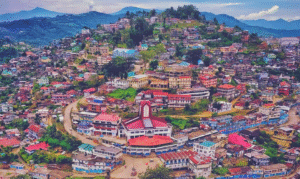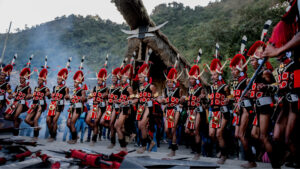Welcome to the vibrant world of the Mising tribe, a lively community living in the fertile plains of Assam. As one of the largest tribes in Northeast India, the Misings have a rich cultural heritage deeply connected to the Brahmaputra and Subansiri rivers. Let’s explore their history, customs, and way of life, celebrating their remarkable legacy.
A Journey Through Time
Originally hill dwellers from the Himalayan foothills of Arunachal Pradesh, the Mising people moved to the fertile plains of Assam over the centuries. Drawn by the rich, fertile soil and the promise of a better life, they settled along the banks of the Brahmaputra and Subansiri rivers. This migration was not just about finding land but also about a significant cultural shift, transforming them from a hill tribe into an essential part of Assam’s diverse community.
A Vibrant Community
Today, about 700,000 Misings live in Assam, with smaller populations in Arunachal Pradesh. They mainly live in the districts of Dhemaji, Lakhimpur, Sonitpur, Golaghat, Jorhat, Sibsagar, Dibrugarh, and Tinsukia. Their settlements along rivers are vital as these waterways support their farming and fishing practices, crucial for their livelihood and way of life.
Despite living alongside the Assamese people for centuries, the Misings have preserved their unique cultural identity. Their traditions beautifully blend agricultural practices, festivals, music, and dance.

Festivals of Joy and Gratitude
- Ali-Ayé-Lígang
The Ali-Ayé-Lígang festival is a 5-day celebration that marks the beginning of the sowing season and the start of a new agricultural year for the Mising community.
The name “Ali-Ayé-Lígang” is derived from two words – “Ali-Ayé” meaning “seeds in a row” and “Lígang” meaning “sowing of seeds”. This festival begins on the second Wednesday of February, which is considered an auspicious day.
The celebrations start with the heads of Mising families ceremonially sowing rice seeds in a corner of their paddy fields in the morning, while praying for a bountiful harvest. In the evenings, the young men and women of the villages gather in the courtyards to sing and dance, accompanied by the beats of drums, cymbals, and a gong that is used only during this festival.
The performers are offered rice beer and chickens by each household. After the singing and dancing, the youth hold a feast on the third day of the festival.
The Ali-Ayé-Lígang festival is a significant event that celebrates the Mising community’s deep connection to agriculture and the start of their annual farming cycle.
- Po:rag
Po:rag is the post-harvest festival celebrated by the Mising people. This festival marks the completion of the paddy rice harvest, which typically takes place in the autumn season, sometimes in the early winter or early spring.
Interestingly, there was a time when the Misings would often harvest their paddy rice in the summer months as well. During those periods, the Po:rag festival would be celebrated earlier, usually in the months of August or September.
- Dobur
They also observe another occasion called Dobur, which is an animistic ritual performed occasionally by the entire village community.
During the Dobur ritual, the villagers sacrifice a sow (female pig) and some hens (chickens) for various purposes. The specific form of the Dobur observance can vary depending on the purpose behind the ritual.
The most common form of Dobur involves the younger male members of the village going around and beating the walls of every house in the village with large sticks. They do this to drive away any “ghosts and goblins” that may be hiding in the houses.
After this ritual cleansing, the villagers come together to hold a communal feast.
Weaving Tradition
The Misings are known for their tradition of weaving. Mising girls are taught to weave at a young age, and this skill is passed down through generations. The materials used in weaving include natural fibers like cotton and silk, and the designs often draw inspiration from nature, reflecting the tribe’s connection to their environment.
A missing loom typically comprises a wooden frame which is the base of the shuttle loom. The Charkha, bamboo and wooden spools, and spools for throw shuttle loom are some important components of a traditional Mising loom.
- Ege: The Ege is a traditional garment worn by Mising women, consisting of a strip of cloth that is wrapped around the waist and extends down to the knees. This versatile piece can be made from various materials and is often adorned with colorful patterns.
- Ribi Gaseng: The Ribi Gaseng is a long sash approximately 8 feet in length and 1½ feet in width, worn by Mising women. The Ribi Gaseng is often used to accentuate the Ege and is an essential part of traditional Mising attire, representing beauty and femininity.
- Seleng Gasor: The Seleng Gasor is a traditional shirt worn by Mising women. Typically made from handwoven fabric. The Seleng Gasor complements the Ege and Ribi Gaseng, contributing to the overall traditional look of Mising women.
- Mibu Galuk: The Mibu Galuk is an ancient shirt worn by Mising men, particularly by priests (Mibus) during religious ceremonies. This garment is often more elaborate than everyday wear and is made from high-quality textiles, reflecting the importance of the priest’s role in the community. The Mibu Galuk symbolizes spiritual authority and cultural heritage.
- Yakan Age-Gasar: The Yakan Age-Gasar is another traditional shirt worn by Mising men. This garment is typically made from handwoven fabric and features unique designs that represent the wearer’s identity and status within the community.
- Gonro Ugon: The Gonro Ugon is a traditional dress for Mising women that covers the entire body from the chest to the calf. This garment is often made from colorful, handwoven fabric and is designed for both modesty and comfort. The Gonro Ugon is typically worn during festivals and special occasions.
- Galeng: The Galeng is a traditional necklace worn by Mising women, made from colorful stones. This piece of jewelry is often worn as part of the traditional attire and adds a decorative touch to the overall look.
Music and Dance
Music and dance are the heart of Mising culture. From the devotional Ahbang hymns to the romantic Tebo Tekang songs, their music captures their experiences and emotions. The lively Gumrag dance, performed during the Ali-Ayé-Lígang festival, is a sight to behold with its rhythmic beats and vibrant movements.
Social Structure
The Mising society is organized into clans, each with a unique surname. Marriages within the same clan are prohibited, ensuring a broad social network. The concepts of Gumin (lineage) and opin (clan) are central to their identity, reflecting their strong sense of community.
Conclusion
In recent years, the Mising community has embraced various developmental schemes to improve their living standards. However, they remain committed to preserving their cultural heritage, balancing modern life with tradition. Organizations like the Mising Bane Kebang and the Takam Mising Porin Kebang play crucial roles in advocating for their rights and autonomy, ensuring their voices are heard in the broader socio-political landscape. Their story is a reminder of the importance of preserving cultural heritage while embracing progress.






